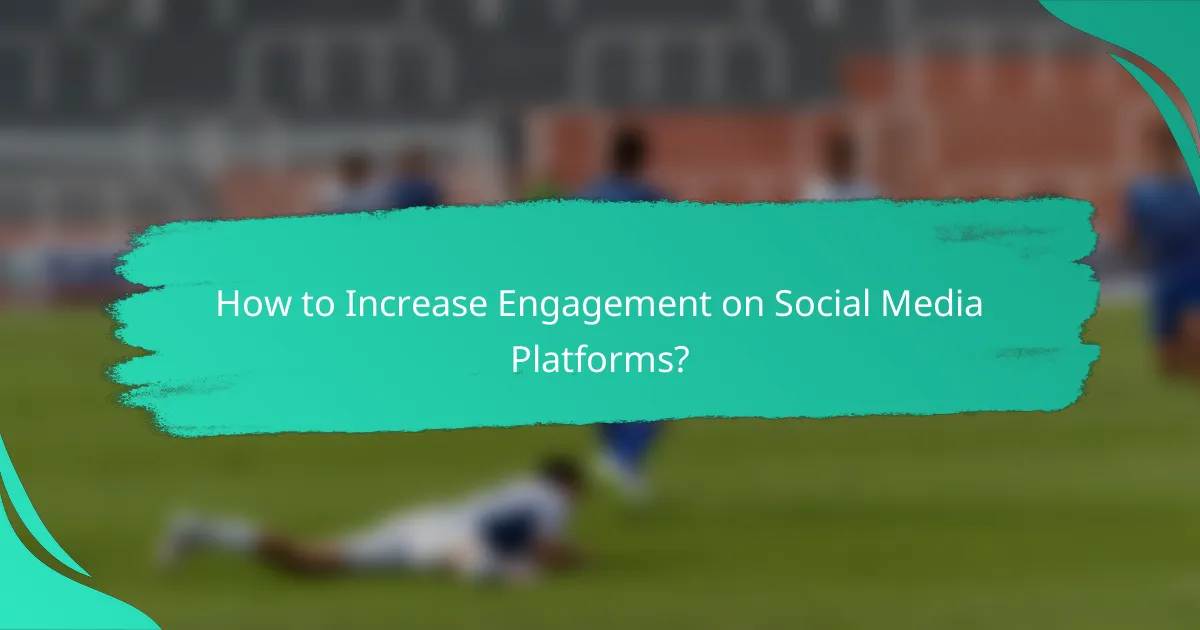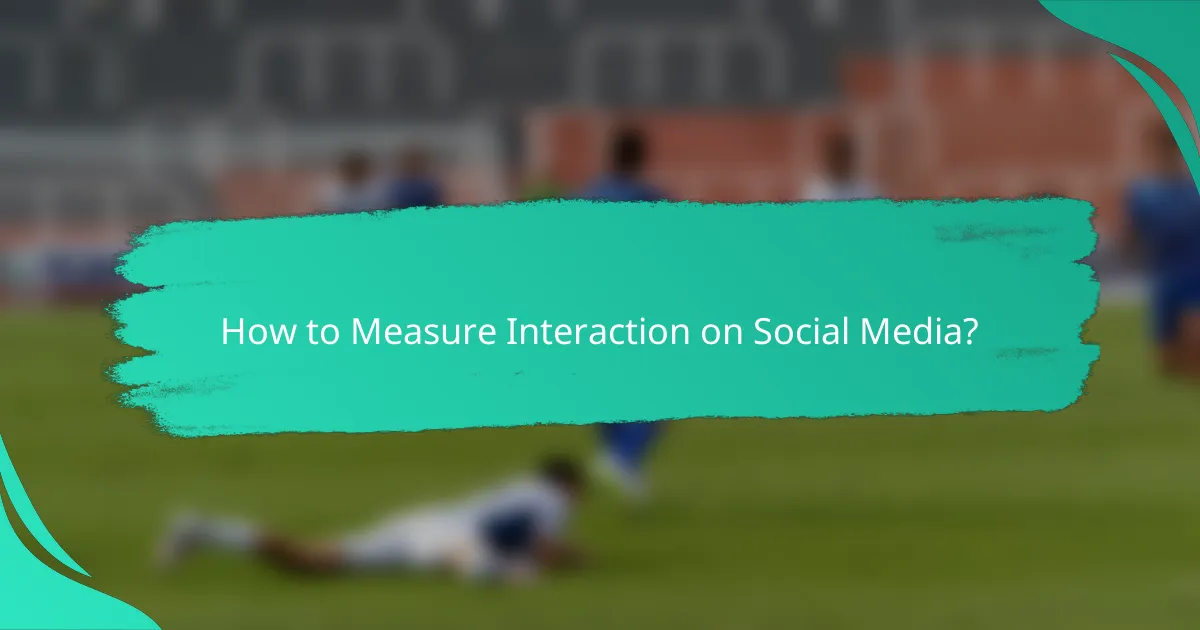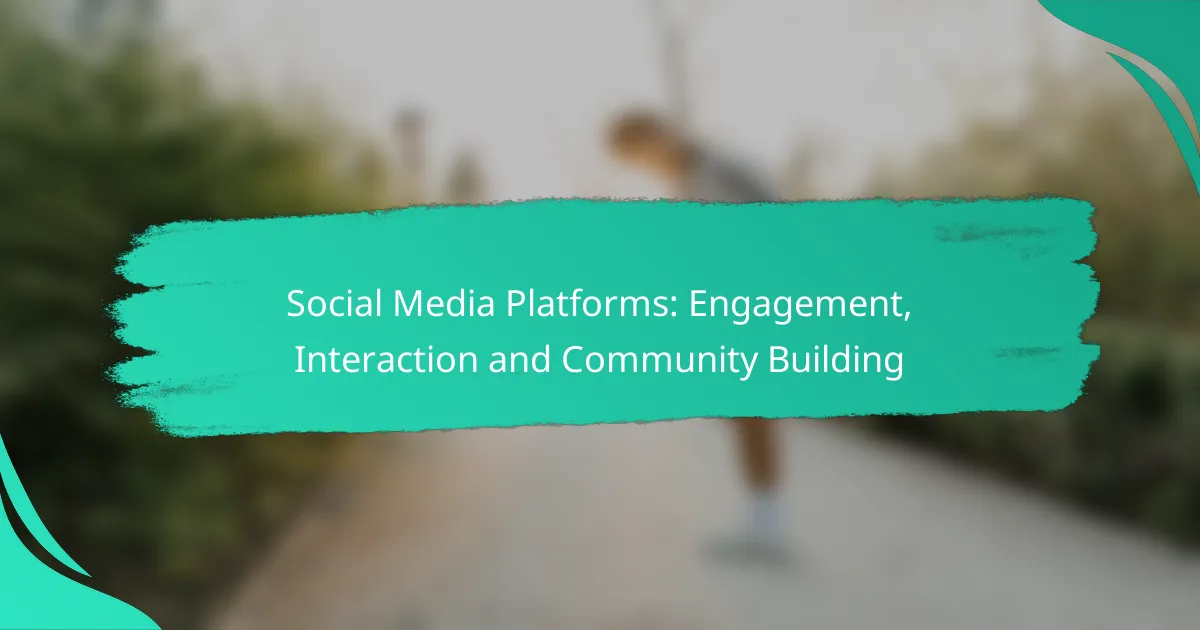Social media platforms serve as vital spaces for engagement, interaction, and community building, enabling users to connect and share ideas. By focusing on high-quality content and consistent interaction, brands can cultivate vibrant communities that encourage active participation. Different platforms, such as Facebook Groups and Discord, offer unique features tailored to diverse audiences, enhancing the community-building experience. Understanding key metrics like engagement rate and shares is essential for measuring the effectiveness of these interactions.

How to Increase Engagement on Social Media Platforms?
To increase engagement on social media platforms, focus on creating high-quality content, maintaining a consistent posting schedule, and actively interacting with your audience. These strategies foster a vibrant community and encourage users to participate more actively.
Content Quality
High-quality content is crucial for engaging users on social media. This includes well-researched articles, captivating visuals, and relatable posts that resonate with your target audience. Aim for a mix of informative, entertaining, and inspiring content to keep followers interested.
Consider using storytelling techniques to make your posts more relatable. For example, share personal experiences or customer success stories that highlight your brand’s values and mission.
Posting Frequency
Establishing a consistent posting frequency helps keep your audience engaged. Depending on the platform, aim for a few times a week to daily posts. For instance, Instagram and Facebook benefit from daily updates, while Twitter may require multiple posts per day.
Monitor engagement metrics to find the optimal posting frequency for your audience. Adjust your schedule based on when your followers are most active to maximize visibility and interaction.
Audience Interaction
Engaging directly with your audience is essential for building a community. Respond to comments, answer questions, and acknowledge user-generated content to foster a sense of belonging. This interaction encourages followers to engage more frequently.
Consider hosting Q&A sessions or live discussions to deepen connections. These formats allow for real-time interaction and can significantly boost engagement levels.
Use of Hashtags
Using relevant hashtags can increase the visibility of your posts and attract a broader audience. Research popular hashtags within your niche and incorporate a mix of trending and specific tags to reach both general and targeted users.
Avoid overloading your posts with hashtags; 5 to 10 well-chosen tags are often sufficient. This approach helps maintain a clean aesthetic while still enhancing discoverability.
Visual Content
Visual content, such as images, videos, and infographics, tends to generate higher engagement than text-only posts. Use eye-catching visuals to complement your messages and convey information quickly. Platforms like Instagram and Pinterest thrive on strong visual content.
Experiment with different formats, such as short videos or carousel posts, to see what resonates best with your audience. High-quality visuals can significantly enhance your brand’s appeal and encourage shares and interactions.

What Are the Best Platforms for Community Building?
The best platforms for community building include Facebook Groups, Discord Servers, Reddit Communities, and LinkedIn Groups. Each platform offers unique features that cater to different audiences and engagement styles, making them suitable for various community-building strategies.
Facebook Groups
Facebook Groups are designed for community interaction, allowing users to create private or public spaces for discussions. They support various formats, including posts, polls, and events, which can foster engagement among members.
To effectively use Facebook Groups, focus on creating clear guidelines and actively moderating discussions. Regularly posting engaging content and encouraging member participation can help maintain a vibrant community.
Discord Servers
Discord Servers provide a real-time chat environment, ideal for communities that thrive on immediate interaction. Users can create channels for specific topics, making it easy to organize discussions and events.
When setting up a Discord Server, consider using bots for moderation and engagement. Offering voice channels can enhance community interaction, especially for gaming or hobbyist groups. Ensure that you promote a welcoming atmosphere to attract and retain members.
Reddit Communities
Reddit Communities, or subreddits, allow users to share content and engage in discussions around specific interests. The upvote/downvote system helps surface valuable content, making it easier for members to find relevant discussions.
To build a successful Reddit Community, establish clear rules and actively participate in discussions. Regularly posting quality content and encouraging users to share their experiences can help grow your community. Be mindful of Reddit’s guidelines to avoid bans or restrictions.
LinkedIn Groups
LinkedIn Groups are tailored for professional networking and discussions. They allow members to share industry insights, job opportunities, and professional advice, making them suitable for career-oriented communities.
To maximize engagement in LinkedIn Groups, share valuable resources and initiate discussions on trending topics in your industry. Encourage members to connect and network, but avoid overly promotional content to maintain a professional atmosphere.

How to Measure Interaction on Social Media?
Measuring interaction on social media involves analyzing various metrics that reflect user engagement with your content. Key indicators include engagement rate, reach, impressions, comments, and shares, each providing insights into how well your audience connects with your posts.
Engagement Rate
The engagement rate is a crucial metric that indicates the level of interaction your content receives relative to your audience size. It is typically calculated by dividing the total engagement (likes, comments, shares) by the total followers or reach, then multiplying by 100 to get a percentage.
A higher engagement rate suggests that your content resonates well with your audience. Aim for engagement rates of around 1-5% for most platforms, but remember that this can vary widely by industry and platform.
Reach and Impressions
Reach refers to the total number of unique users who see your content, while impressions count how many times your content is displayed, regardless of whether it was clicked or not. Understanding both metrics helps gauge the visibility of your posts.
To maximize reach, consider posting during peak times when your audience is most active. Regularly analyze these metrics to adjust your strategy and improve content visibility, aiming for a balance between reach and engagement.
Comments and Shares
Comments and shares are direct indicators of user interaction and content value. Comments provide qualitative feedback, while shares amplify your content’s reach by exposing it to new audiences.
Encourage comments by asking questions or prompting discussions in your posts. For shares, create shareable content that resonates emotionally or provides value, such as tips or entertaining visuals. Monitor these metrics to understand what drives interaction and adapt your content strategy accordingly.

What Tools Can Enhance Social Media Interaction?
Several tools can significantly improve social media interaction by streamlining content management, scheduling, and analytics. Utilizing these platforms allows businesses to engage their audience more effectively, track performance, and foster community building.
Hootsuite
Hootsuite is a comprehensive social media management tool that enables users to schedule posts, monitor engagement, and analyze performance across multiple platforms. It supports a wide range of social networks, making it ideal for businesses looking to maintain a consistent online presence.
One key feature of Hootsuite is its ability to track social media conversations and mentions in real-time, allowing brands to respond quickly to customer inquiries or feedback. This responsiveness can enhance community interaction and build stronger relationships with followers.
Buffer
Buffer focuses on simplifying the scheduling and publishing of social media content. Users can plan posts in advance, ensuring a steady flow of content without the need for constant attention. This can be particularly useful for small businesses or individuals managing multiple accounts.
Buffer also provides analytics that help users understand which posts perform best, allowing for data-driven adjustments to content strategy. Its user-friendly interface makes it accessible for those who may not be tech-savvy, promoting effective engagement without a steep learning curve.
Sprout Social
Sprout Social offers robust tools for social media management, including scheduling, monitoring, and reporting features. Its emphasis on collaboration makes it suitable for teams, allowing multiple users to manage accounts and share insights seamlessly.
A standout feature of Sprout Social is its customer relationship management (CRM) capabilities, which help businesses track interactions with followers and tailor their engagement strategies accordingly. This personalized approach can significantly enhance community building and foster loyalty among users.
